If you asked most people what color egg yolks are, they would likely answer yellow.
Yolks have always been associated with the color yellow, which is unfortunate because backyard chicken keepers know better.
Backyard chicken keepers know that yolks can—and should—be a bright, bold orange, and those bright, bold orange yolks are a sign of happy, healthy hens.
In an unscientific home experiment, I compared my pasture-foraging, insect-pecking, soil-scratching, whole grain-feeding chickens’ yolks to the yolks of both their “free-ranging” and factory-farmed counterparts.
The results were clearly visible: Yolks from my homegrown eggs were not only darker, but also fuller and thicker. Even the eggshells were denser and harder to crack.
But what’s the big deal about orange yolks?
Turns out that besides being a coveted color, orange yolks can be an indication of a well balanced and highly nutritious diet.
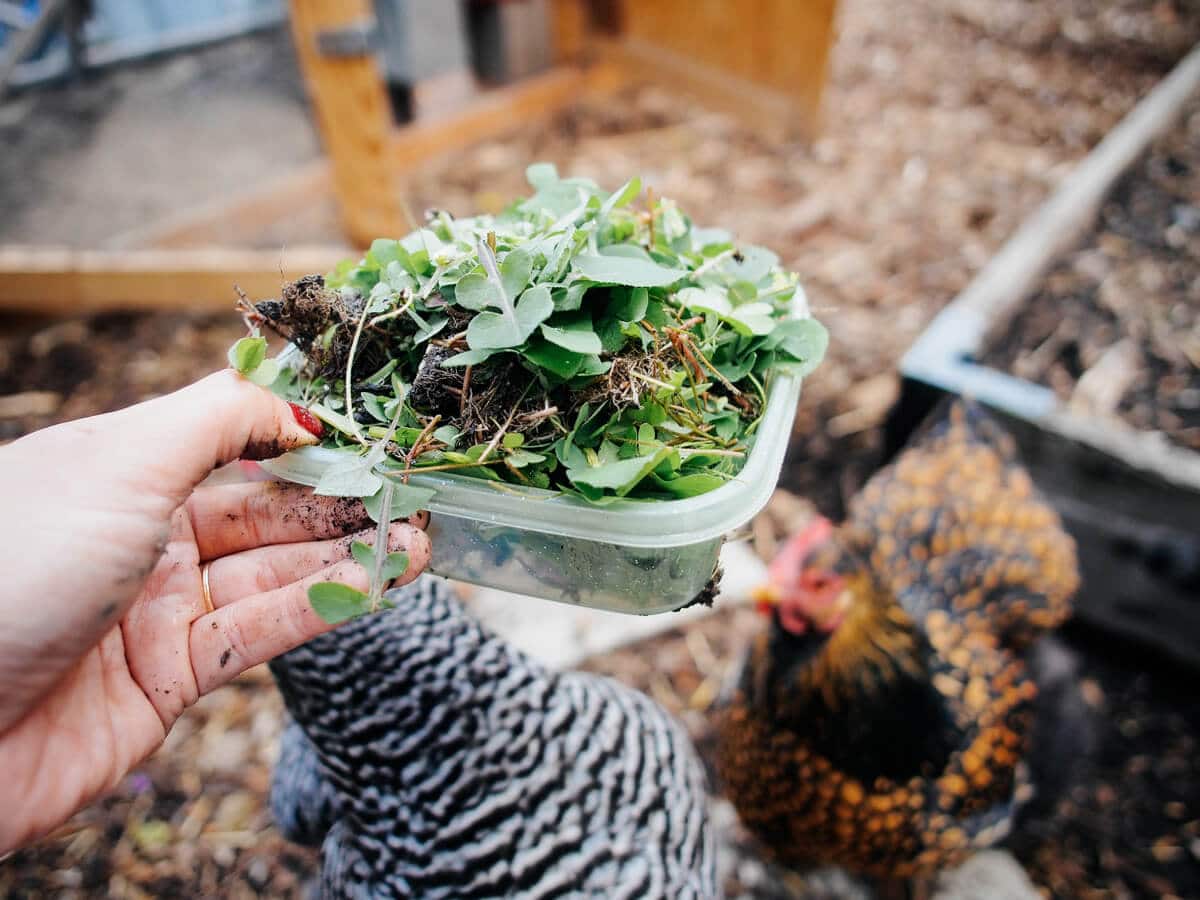
What makes egg yolks orange?
A few things factor into the making of an orange yolk: xanthophylls, omega-3 fatty acids, and meats.
Xanthophylls
The chemicals responsible for yolk coloring were first documented in 1915 in the Journal of Biological Chemistry.
Dr. Leroy Palmer wrote that “The consumer demands highly colored yolks in ‘fancy’ eggs throughout the year, and the eggs with pale colored yolks, so frequently found on the market during the winter months, are the object of much complaint, particularly in cities.”
He determined that orange yolks were produced by a class of carotenoids called xanthophylls, and over 100 years later, this conclusion is still widely accepted.
Carotenoids are natural plant pigments found in many fruits and vegetables. It’s often thought that beta-carotene, one of the more well-known carotenoids, is responsible for giving yolks the orange pigment that people associate with carrots.
But in actuality, beta-carotene benefits yolks nutritionally, rather than pigment-wise.
Read More: Propaganda Told Us Carrots Can Improve Eyesight—Here’s the Truth
The carotenoids that cause deeper yolk coloring are xanthophylls, which are more readily absorbed in the yolks. (Lutein is one such xanthophyll, and a lot of lutein means a lot more orange.)
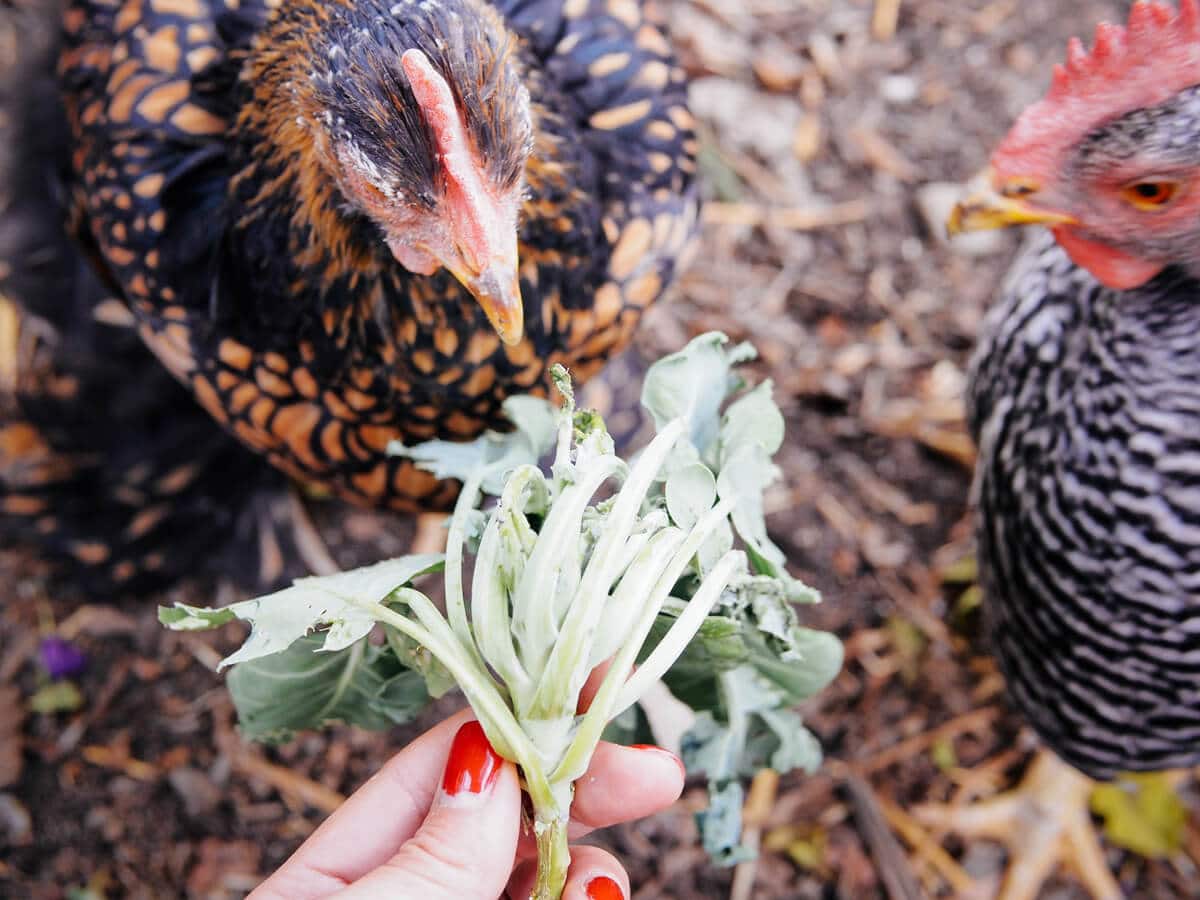
Xanthophylls are found in dark leafy greens like spinach, kale, and collards, as well as in zucchini, broccoli, and brussels sprouts.
(I know it seems weird that a carotenoid that turns egg yolks orange is found in green vegetables, but stay with me here.)
Related: Why Purple Beans Turn Green After Cooking (A Kitchen Magic Trick!)
Omega-3 fatty acids
Omega-3 fatty acids are highly concentrated in oily fish (especially cold-water fish like salmon, tuna, and mackerel), shellfish, algae, tofu, and high-fat plant foods (like brusssels sprouts, navy beans, and avocados).
They’re also found in flax seeds and sea kelp, which are both important components of my homemade whole-grain chicken feed.
Meat
Did you know that chickens are not meant to be vegetarian, no matter what your premium carton of organic/grain-fed/cage-free eggs tells you?
Chickens are omnivores by nature and their healthiest diets include meats, such as mealworms, beetles, grasshoppers, grubs, and whatever creepy-crawly they can pull out of the ground. I’ve even heard of chickens attacking and feeding on small rodents and snakes!
And yes, you can even feed your chickens the leftover cooked chicken from last night’s dinner (no matter how wrong that may sound). It’s good for them, and won’t turn them cannibalistic.
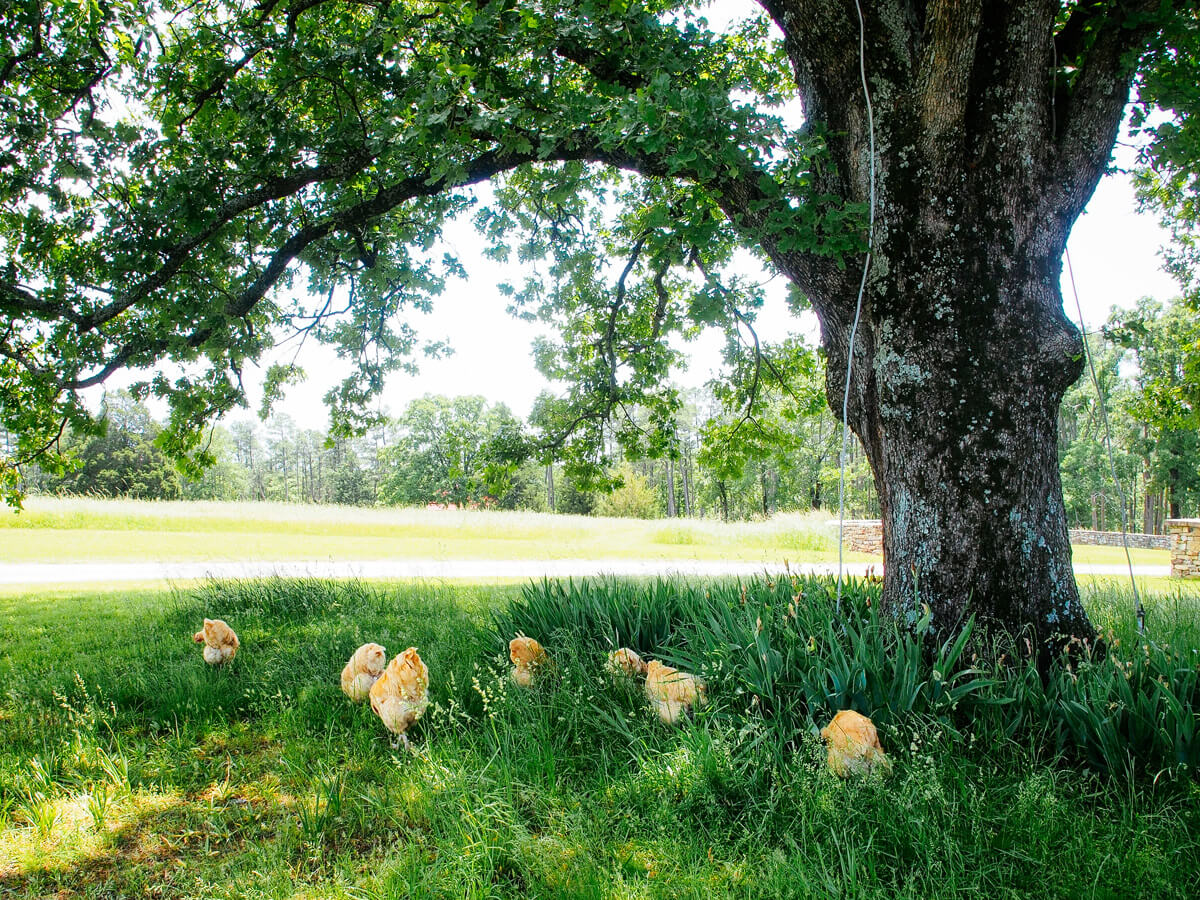
Are dark orange yolks healthier for you?
Yes and no.
You see, color alone has very little to do with the nutritional content of an egg yolk. Yolk color depends almost entirely on the pigments found in the food that chickens eat.
When hens eat a diet that’s heavy in yellow corn, they lay eggs with medium-yellow yolks. A diet of wheat or barley results in eggs with lighter-colored yolks, and a colorless diet (such as white corn) produces nearly white yolks.
In fact, it’s so easy to “dye” the color of a yolk that a Santa Fe, New Mexico farmer, Matt Romero, is known for his legendary flame-colored egg yolks, which he gets simply by feeding his hens the leftover red chile peppers from his farm.
Other farmers “hack” their way to darker yolks by feeding their flocks marigold petals (which produces deep yellow yolks) or even using synthetic chemicals like Rovimix Carophyll Yellow, Canthaxanthin, Xanthophyll B, and Lucantin Red to achieve the dark yolks they think their consumers prefer.
This is why you should be leery of cheap eggs from the supermarket whose yolks come out orange.
On the flip side, there’s cause for concern if store-bought “free range” or “pastured” eggs have very pale yolks. It could mean the egg producer is only giving the hens minimal access to the outdoors, like a single door out to a patch of grass.
Foods That Naturally Impact Egg Yolk Color
| Yolk Color | Ingredients |
|---|---|
| Nearly colorless | White cornmeal |
| Light yellow | Wheat, barley |
| Medium yellow | Yellow cornmeal, alfalfa meal |
| Dark yellow | Marigolds, leafy greens, alfalfa |
| Orange to red | Pumpkins, tomatoes, red peppers |
But, there’s a big but to all this…
Chickens whose diets are rich in leafy greens, flowers, seeds, weeds, and meat lay eggs with naturally darker yolks. The xanthophylls, omega-3 fatty acids, vitamins, and minerals in these food sources are then passed on to their eggs and concentrated in their yolks.
Research has shown that of all the nutrition found in eggs, most of it is found in egg yolks, including fat-soluble vitamins like D, E, K, and A (none of which you get from egg whites), essential fatty acids like DHA and ALA, and other nutrients like calcium, iron, magnesium, zinc, choline, and B vitamins.
According to Mother Earth News, which conducted its own egg analysis, and a more recent Pennsylvania State University study, pastured eggs (where hens are given free range with ample access to greens and bugs) contain higher levels of vitamins A, D, and E, more beta-carotene, and more omega-3s than eggs from caged chickens fed primarily grain.
All this means is that a pastured egg (ideally from your own yard) is healthier for you. And that’s one of the reasons we raise chickens, right?
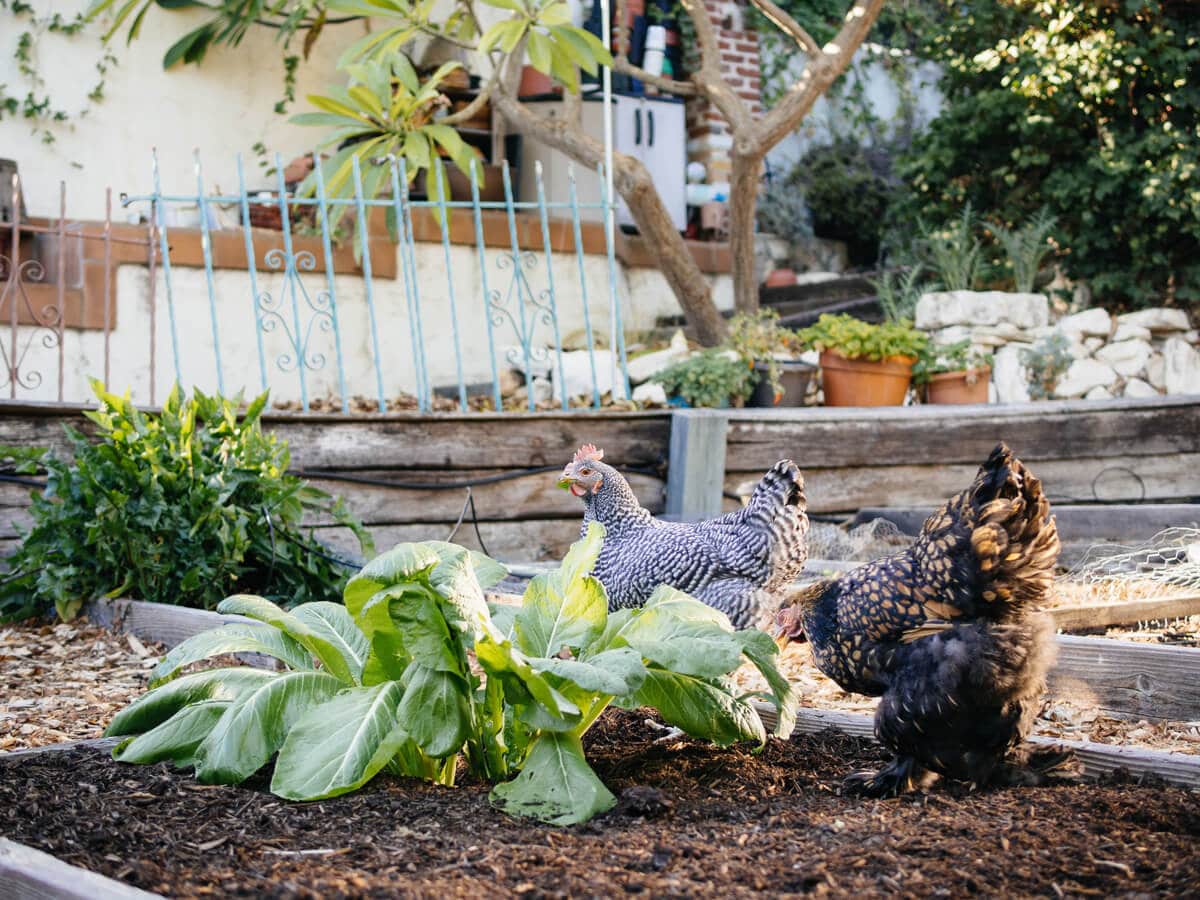
How to get dark orange yolks from your chickens
1. Let your chickens free-range.
Let your ladies roam a pasture (or a garden—especially if you’re digging over soil—or even just a new patch of dirt in their chicken tractor) for an orange-boosting bug buffet. They like to scratch through leaf piles and layers of mulch where protein-rich grubs and tasty earwigs often hide.
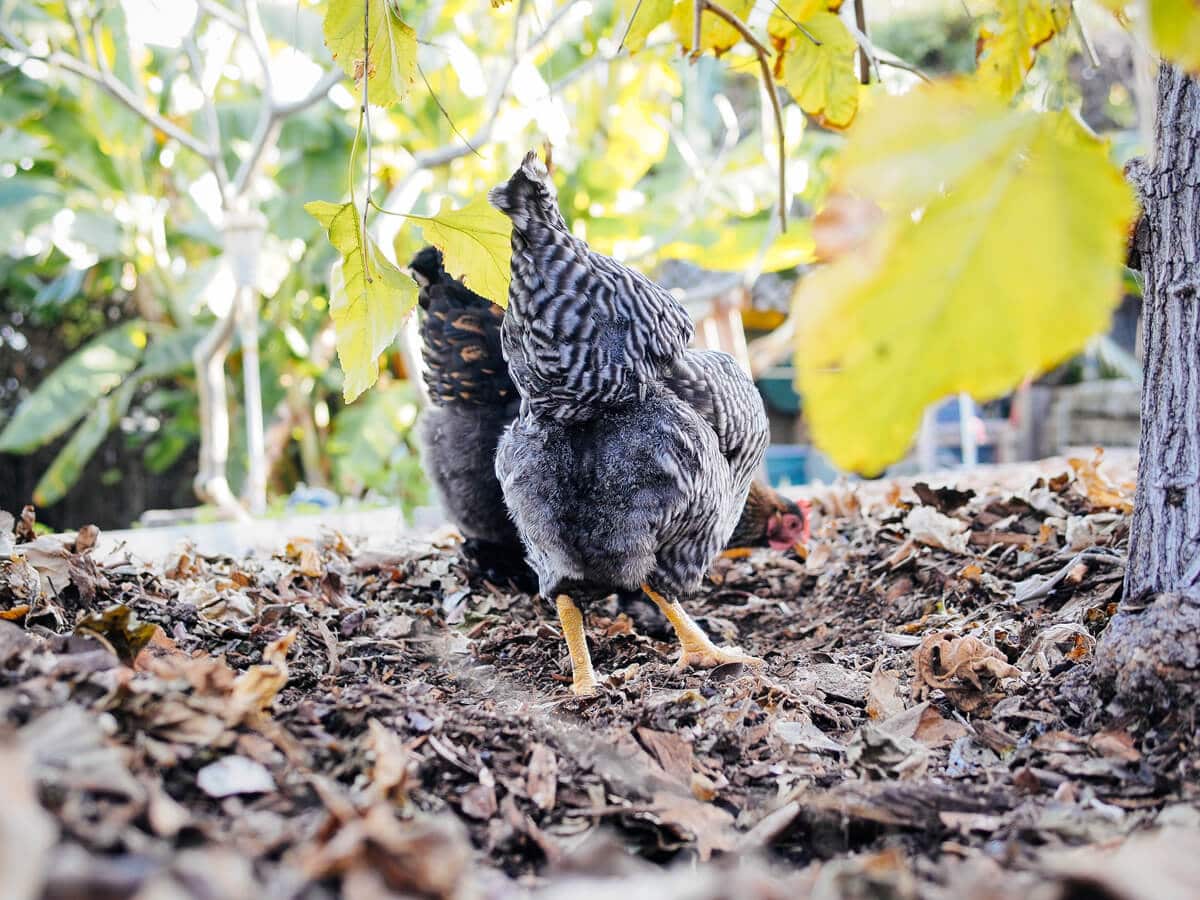
If it’s recently rained, let your chickens out so they can hunt for worms, sowbugs, slugs, centipedes, and other bugs that emerge when things get more damp.
Pastures (or backyards) full of rich grasses, ground covers, and cover crops are a wonderland for your flock, giving them plenty of opportunity for forage and exercise.
2. Feed your chickens lots of leafy greens.
Give your chickens plenty of fresh greens to increase the lutein in their yolks.
The darker the green the better, so I often fix them a feast of edible amaranth (one of my favorite summer greens), kale, mustard greens, broccoli leaves, or whatever I happen to have growing in my garden.

If it’s the middle of winter and your garden greens are lacking, you can give them alfalfa for a nutritional boost.
3. Let the chickens weed the garden for you.
Rather than pulling all those (vitamin rich!) weeds out of your garden, let your chickens do the dirty work! They love to forage for dandelions, mallow, clover, oxalis, chickweed, purslane, and other plants that sometimes grow where they shouldn’t.

In fact, these types of weeds can be cultivated in a landscape especially for your flock, as they’re low-maintenance and make a lovely, natural, and “wild” lawn that benefits other wildlife as well.
Learn more: Best Edible Ground Covers for Vegetable Gardens
4. Enlist your chickens in yard clean-up.
Chickens are very handy helpers at the end of the season when most of your plants have bolted and become aphid-ridden.
Let the chickens clean up those plants before you toss them into the compost. It’s a win for everybody! (Except the bugs, that is…)

Not only will they take care of the pests on your spent plants, they’ll eat whatever’s left on the stems, including flowers and seeds.
5. Let your chickens turn the compost pile.
If you have an open compost pile, chickens do good work of turning over yard debris and kitchen scraps as they scratch and peck for grubs and worms. (Black soldier fly larvae, which are commonly found in decaying organic matter, have even more protein than mealworms and are naturally high in calcium.)
You can start a compost pile in a corner of the chicken run, or build a compost bin inside the run that’s open on one side (and can be covered as needed).
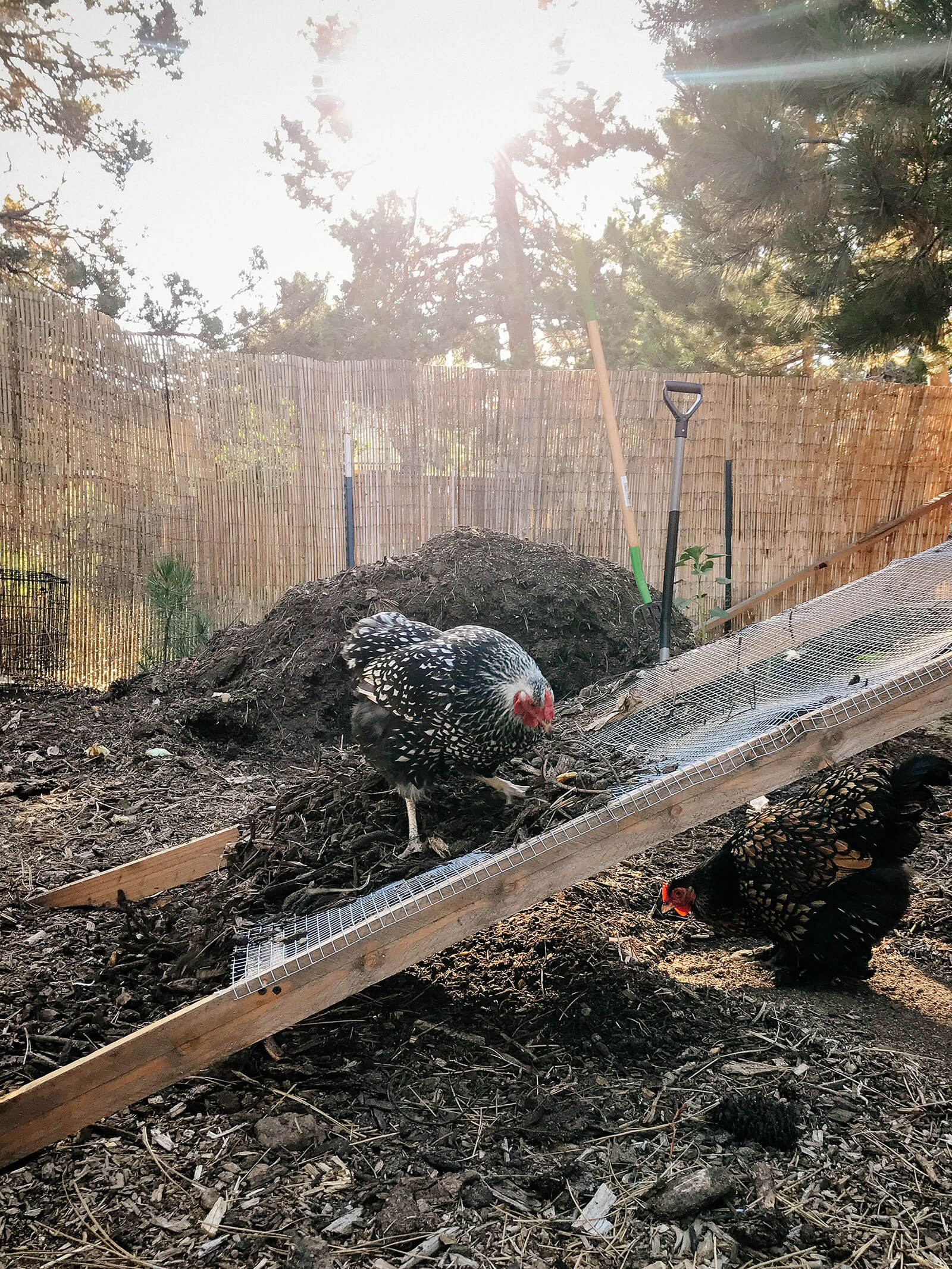
The chickens will eat what they want, shred up your scraps for quicker composting, and keep themselves busy and entertained on days they can’t free-range (which means less hen pecking among the flock).
After a few weeks, you’ll be so used to seeing orange yolks (the way most of us have been conditioned to see yellow yolks) that you might even think they haven’t changed in color.
Buy some eggs from the store and crack them into a bowl with your homegrown eggs—you’ll be stunned at the difference!
This post updated from an article that originally appeared on March 7, 2013.
View the Web Story on how to make chickens’ egg yolks darker.


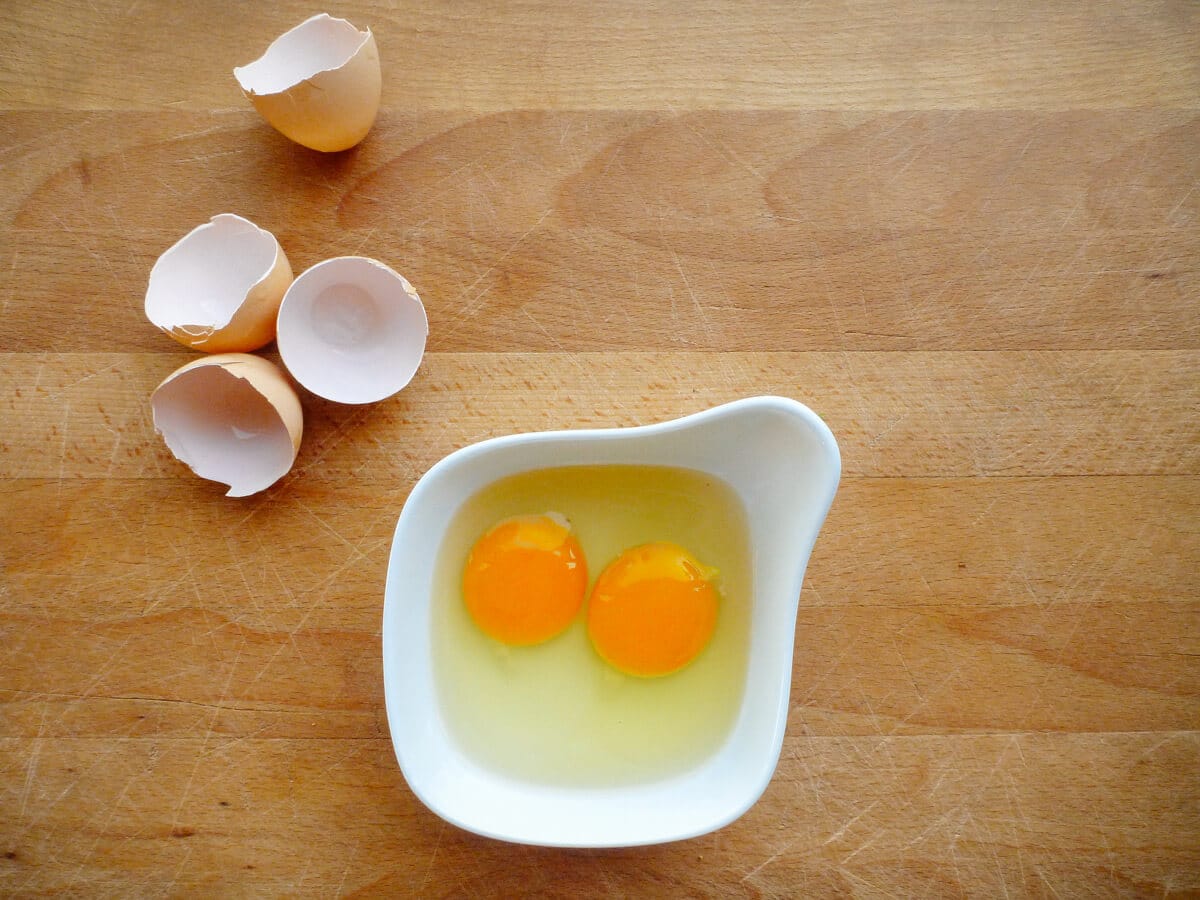













We raise a whole row of “perennial tree collards” ( sometimes called tree kale) specifically for our pastured chickens. It seems to be their favorite vegetable. Out here in N. CA near the coast the tree collards produce new leaves all year long, and the plants live for many years
Our chickens’ eggs are quite orange, but the yolks get almost into the “red” category when we give them the many left over bruised or cracked open tomatoes and red peppers!!
We’ve also got a lot of wild pigweed (amaranth) that we pull out of the garden, and the chickens like this quite a bit too.
I love tree collards! We have overwintered broccoli plants (that will be going into their second winter soon) which very much resemble tree collards at this point. They’ve been sustaining our chickens all year long. Fallen cherry tomatoes and tomato leaves are also a favorite for them! (Really, what don’t they eat?)
I thought tomatoes were not suppose to be fed to chickens?
I have never heard that, and I don’t know of any valid reason why they can’t eat tomatoes.
is raw oatmeal bad, they love it.
Chickens can eat both whole oats (or any form of oats) as well as cooked oatmeal. You can learn more about chicken nutrition here: http://gardenbetty.com/2012/06/garden-bettys-homemade-whole-grain-chicken-feed/
they forage all day, but it’s just a good size average city backyard. so I do supplement with bugs and worms. they’re rotten girls.
They won’t eat greens. R mealworms bad 4 them?
And it’s summer here.
Mealworms are a good source of protein for them and should be given as a treat. Let them forage for other bugs on their own.
One more question. Does that apply on quails?
I don’t know, as I don’t raise quail.
How long does it take to change yolk color?
That depends on your chickens. For all dietary changes, I usually wait a couple of weeks to gauge any results.
HELP! my eggs have turned yellow. i’m so upset. im here trying to figure out what happened. they crave oatmeal, which I’ve supplied. is that my mistake? i’ve tried to give them greens, they show no interest. what can I do?
Is it summer or winter where you are right now? Yolks tend to be lighter in winter since greens and bugs are not as abundant and chickens’ dietary needs change with the seasons. I’ve always felt that they know what their bodies need and eat accordingly, so continue to give them what they crave. Try a variety of different greens and vegetables (I offer kitchen scraps, like squash and tomatoes), and toss out mealworms as a treat.
The first time i saw an orange yolk from an egg produced locally, i thought the egg was bad–I was so used to seeing very pale yellow yolks. Pretty sad!
I think most people have only seen pale yellow yolks, so it’s such a gift that we’re able to see orange ones. 🙂
I’m new to chickens – I currently have 2 one year old laying hens that I purchased this summer and about 20 pullets that will start laying this fall. I live in Wisconsin and am curious if the orange yolks change to a lighter color in the winter?
If your chickens won’t have access to fresh greens in winter, then yes, their yolks will be lighter.
My backyard-big-city Rhode island red hunted, killed, and ate a mouse once. I wouldn’t have believed it if I hadn’t seen it with my own eyes. Then the other girls chased her around until the carcass was shredded and devoured. They’re basically tiny dinosaurs.
I wish our chickens would take care of our mice problem!
We call that “chicken football” around here. LOL!!! Want to have some fun, throw a mouse or toad out in the middle of twenty hens or so and just sit back and watch. Oh, it is also funny when they grab some bumble bees!!!
That sounds so gruesome! 😛
I think that the amount of exercise hens gets makes a difference in the quality of their eggs. And if they can eat plenty of earthworms, bugs, and even the occasional field mouse, their eggs will be even better. I had fun with an egg yolk today. I’m amazed at how thick the egg yolks are.
http://wp.me/p44c6k-tU
Have your hens started laying yet? If so… How to Get Those Delightful Dark Orange Yolks From Your Backyard Chickens http://t.co/VJXHshTnEM
Ive had people freak when I mention that I feed my birds meat and even chicken organs etc. When I make broth I cook it three times and at the end I have this bone and veggie mush. The chickens get that, veggie clippings, I sprout for myself and they get some of that also and my birds completely free range. I have a huge area in the barn for them at night and during the day they run around my barn and the horses pasture and paddocks. They LOVE rummaging around the horse manure for bugs and Larvae!
I am sooo glad to see that you also disagree the oft-believed notion that chickens are vegetarians! I’ve been arguing w/ my friends about this commercial on TV now about “farm raised chickens fed a pure vegetarian diet” that supposedly produces better eggs. “Hogwash!”, I say. I tell them how do you expect a 5# hen to produce a 100 Kcal egg every day that’s nearly 100% protein if she’s only getting grain that’s 8-9% protein? Those farms have to be supplementing with soy (true, it’s “vegetarian”, but who wants those phytoestrogens?) or whey! Regarding orange yolks, I supplement my flocks w/ daily treats of premium cat food and calf manna (I can’t free range cuz of varmints), and add a tablespoon of marigold powder (that I found on Amazon for $66 for a Kg). I get gorgeous orange eggs that I’m sure are full of Lutein and other xeoxanthines!
my chickens’ eggs just turned paler yellow! I found you while searching for the reason. There are only two laying and we just got 4 more pullets. I’m thinking that they have been stressed and perhaps foraging less(?) I’ll try providing them with more and see if this changes soon. I want my dark orange yolks back!
It’s possible that new pullets in the coop (or any environmental factors, like extreme weather changes, etc.) would stress out your laying hens. Give them a few weeks to adjust and keep feeding them fresh greens!
Hi Linda. Do you store any of your chicken garden veggies for the chickens during the winter months? If so, how do you do it?
No, because I still get plenty of fresh greens in my garden over the winter. Some of them are left over from summer/fall, so as they start to bolt, I pull the entire plants and give them to my chickens. I also feed them all my weeds.
For fellow chicken keepers! How to Get Those Delightful Dark Orange Yolks From Your Backyard Chickens http://t.co/jxeChTQZEw #homesteading
How to Get Those Delightful Dark Orange Yolks From Your Backyard Chickens http://t.co/FKaQXSVSID < TY for RT! @sowandso
Feed them greens and meats: How to Get Those Delightful Dark Orange Yolks From Your Backyard Chickens http://t.co/lIgTY3oPK5 #homesteading
Three things factor into darker yolks: How to Get Those Delightful Dark Orange Yolks From Your Backyard Chickens http://t.co/qEhu7KiqYb
A color to covet: How to Get Those Delightful Dark Orange Yolks From Your Backyard Chickens http://t.co/CktyJrN32T #homesteading
RT @theGardenBetty: Giving them greens is one way! How to Get Those Delightful Dark Orange Yolks From Your Backyard Chickens http://t.co …
Giving them greens is one way! How to Get Those Delightful Dark Orange Yolks From Your Backyard Chickens http://t.co/FKaQXSVSID
RT @Tuinsmakelijk: Wat maakt dat de eigelen van kippen die goed leven oranje zijn? http://t.co/e59vuih1wp
Wat maakt dat de eigelen van kippen die goed leven oranje zijn? http://t.co/e59vuih1wp
Angie Smith liked this on Facebook.
A sign of a happy, healthy hen: How to Get Those Delightful Dark Orange Yolks From Your Backyard Chickens http://t.co/SDVmF5pqQn
Actually, I was one of those people before I had my own chickens… egg marketing is so deceitful! We need to spread the word and educate.
Attention chicken keepers: How to Get Those Delightful Dark Orange Yolks From Your Backyard Chickens http://t.co/ewYlfuKyQ4 #homesteading
Donika Engstrom liked this on Facebook.
Nell Wade liked this on Facebook.
What about the fact that most, if not all, alfalfa is GMO in the United States? Healthy chickens eating horrible GMOs doesn’t seem like a great thing. What should you feed them then?
For backyard chicken keepers, I consider alfalfa to be a last resort if you can’t source fresh greens for your chickens. If you don’t grow your own greens, you can buy overstock produce from farmers’ markets or even a place like Whole Foods, which would ordinarily just throw them away.
Thanks! That is a great suggestion! We don’t have any chickens yet, but I want to learn everything possible right now!
Eva Stuart liked this on Facebook.
I do come across many people who buy our eggs thinking that chickens are vegetarians and should eat only grains and plant food. You can see their surprise when I tell them they are not and actually they can be cannibals too if not prevented. Sad, but true! 🙁 Thanks for sharing this article.
Leigh Sherrod liked this on Facebook.
Cristyane Lamastra-Conner liked this on Facebook.
Jun Iguchi liked this on Facebook.
Karen Jordan liked this on Facebook.
How to Get Those Delightful Dark Orange Yolks From Your Backyard Chickens:
If you asked most people what colo… http://t.co/wzs4yVecl7
Blogged on Garden Betty: How to Get Those Delightful Dark Orange Yolks From Your Backyard Chickens http://t.co/1yhFk9PSWu